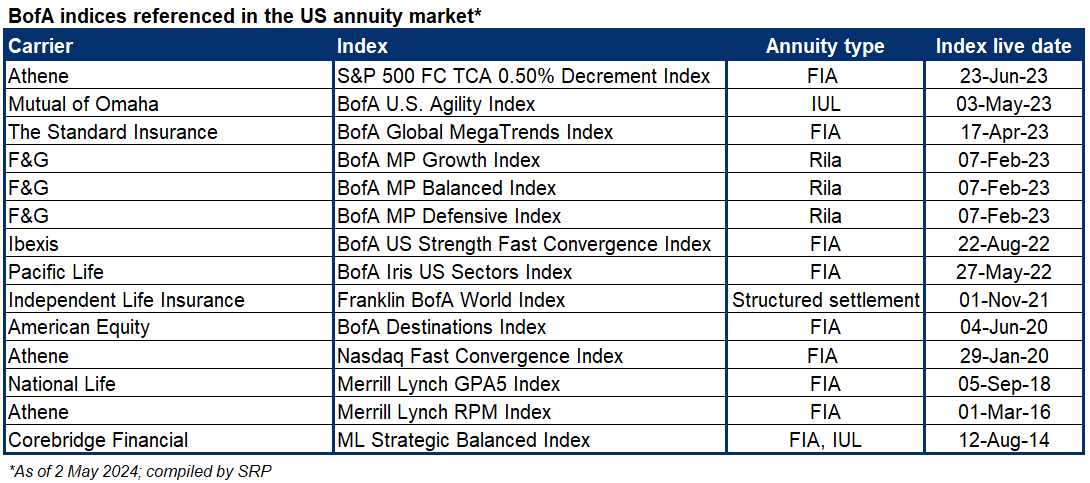Bank of America (BofA) has 14 indices referenced in the US annuity market with nearly US$24 billion in assets.
This year marks the US bank’s 10th year anniversary in the country's annuity market as an index and hedge provider since the debut of its ML Strategic Balanced Index for fixed index annuities (FIAs).
As carriers refresh their index line ups, we have seen demand for indices with higher expected allocations to equities and either minimal exposure to bonds, or sophisticated duration management overlays
Since then, BofA Securities has made headway with its indices being referenced across registered index linked annuity (Rila), index universal life (IUL) and structured settlement beyond FIA – the assets linked to a group of 14 BofA indices referenced in the annuity market stand close to US$24 billion.
“As carriers refresh their index line ups, we have seen demand for indices with higher expected allocations to equities and either minimal exposure to bonds, or sophisticated duration management overlays,” Gabriel Lettieri (pictured), managing director, head of Americas insurance solutions at BofA, told SRP.
Moreover, intuitive and explainable approach to index construction approaches are increasingly valued over back-tested returns, according to Lettieri.
In 2023, FIA sales increased 20% to US$95.9 billion in the US year-on-year while Rila also delivered a record high sales of US$47.4 billion, at a slower rate of 15%, according to Limra.
Lettieri has observed a rise of allocations to both fixed rate and capped exposure to equity benchmark indices over the last three years.
For FIAs, the volatility target or custom index allocations have dropped to 29% in the last quarter of 2023, compared to 33% in Q3 2023 and 60% in Q3 2021 based on the quarterly sales volume, according to annuity research company Wink.
The decline is mainly due to a shift towards market-cap weighted equity benchmarks in a high interest rate environment and underperformance of multi-asset indices, which results from eroded diversification benefits of US treasuries, according to Lettieri.
“As advisors and agents work with clients to rotate out of legacy products with limited growth potential, we believe the perceived simplicity of both fixed accounts and equity benchmarks have taken on greater importance,” said Lettieri. “This shift has benefitted our suite of Fast Convergence (FC) indices, all of which feature high volatility targets and high average equity exposure while referencing well-established equity benchmarks”.
Meanwhile, there is room for innovation around multi-asset and global indices. “US equity market outperformance may not last forever, and it’s important to be prepared for macro shifts through tactical diversification,” he noted, in anticipation of a return of diversification as a strategy in a lower interest rate environment.
Introduced by BofA Securities in 2020, the FC technology is the first intraday volatility targeting approach in the annuity marketplace, according to Lettieri.
One flagship index powered this technology is the Nasdaq Fast Convergence Index which includes a 12.5% volatility target. The Nasdaq 100-linked index is just behind the best-performing one-year participation FIAs in 2023, and products linked to the idnex have posted the highest average credit at 26%, a recent research report by TIS shows.
“One of the major benefits of volatility control is the ability for policyholders to access differentiated strategies in terms of both assets and asset allocation,” said Lettieri.
Banks and asset managers can also apply techniques or technology used by institutional investors in rules-based indices, such as analysis of high frequency data and selection of individual stock or sector through machine learning, according to Lettieri.
Do you have a confidential story, tip or comment you’d like to share? Write to Summer.Wang@derivia.com

